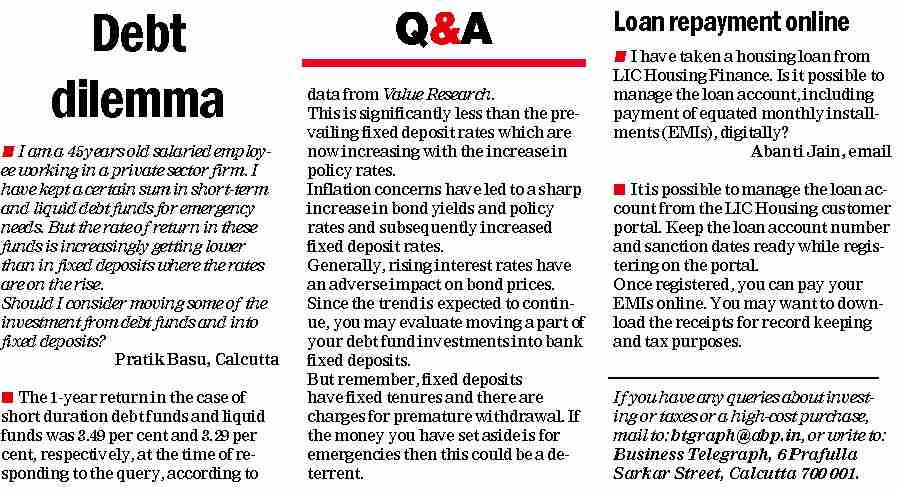All accusations of delayed response notwithstanding, regulatory marksmanship rarely misses the woods for the trees. The banking regulator demonstrated it once again last week when it chose to change its policy in favour of a higher repo rate. Even as the ordinary citizen braces for higher earnings from deposits and escalated borrowing costs, the unscheduled announcement has upended well-laid plans for even the most uppity investor in the debt market. It is indeed time to re-jig investment strategies in keeping with the evolving scenario.
The market will now be subject to a further bout of volatility, a realisation that has prompted professional advisers to recommend absolute caution when it comes to new allocations. Investors are being generally asked not to look much beyond short-term debt. Those who are a bit more defensive but are still keen on assured income, shorter duration deposits are being recommended as a functional solution.
For those who seek variable income, certain categories of low-end debt funds are being offered as the panacea. Exposure to these instruments will help investors tackle the market in a better manner; risks will remain relatively more manageable.
What else can investors consider doing? What can they now do to gain the most from the latest RBI move? Let’s try to answer these questions. Three strategies can be worked out:
• Opt for the short term. Avoid going long as the debt market is not likely to deliver great rewards to those who want to stay in it for lengthy streches of time. At any rate, longer is the duration, more is the uncertainty potentially caused by interest-rate fluctuations.
• This may be time for you to exit from low-yielding instruments and choose those that yield more. However, such exit and entry may cause investment costs to escalate — a critical issue for investors.
• Consolidate your debt portfolio. You may even re-calibrate your allocation pattern and acquire riskier but more promising asset classes. Nevertheless, a sudden switch from conservative debt to aggressive equity is not recommended.
Core holdings
For those who are not too keen on these tactics — perhaps they are wary of tax implications — staying close to a core debt portfolio, comprising a select few instruments, may be considerd necessary. Target Maturity Schemes may find a special place in their holdings. Yields offered by the TMS category (where securities are normally held till maturity) are not too unattractive, relatively speaking.
Investors are also being asked to redirect maturity proceeds, if any, towards instruments bearing higher interest rates. The latter are already a reality, thanks to strategies rolled out by banks and sundry deposit-mobilisers. The latter include financial services companies, a number of which have recently increased their rates.
The vital debate, of course, is whether investors should allocate more to actively-managed debt products (such as bond funds) or acquire more deposits. The first category, I must mention, will face certain headwinds in the days to come. At the end of the day the discerning investor will evaluate risk-adjusted performance, particularly post-tax returns, which is always seen as the key determinant for investments.
The secondary debate relates to the actual allocation process. Many quarters believe that a step-by-step investment programme should be carried out, and I tend to agree with the theory. This is because a few more rounds of rate changes cannot be ruled out. The apex bank is well expected to follow a dynamic policy and adjust key rates in sync with market conditions. I must add in this context that strong inflationary forces are clearly at work at this stage; this will certainly influence policy-related initiatives taken in the future.
A question of bonds
Risk-takers are also being advised to identify a clutch of listed papers and invest directly in order to get the best results. Debt funds, thus, are not being positioned as the preferred solution here. Instead, bonds that are sufficiently liquid (can attract decent trading interest) are being recommended. There is, however, a caveat: trading can turn into a bitter experience if sentiments prevailing in the market turn for the worse and remain so.
Besides liquidity, a number of other metrics should be evaluated. These include YTM, yield to maturity, and YTC, yield to call. The latter of course will be relevant if call options are given to investors. Credit rating too may be seen as a formidable factor that can tilt the scales in favour of (or against) a particular security. Ditto for the issuer company’s track record in servicing debt.
Direct investments are ruled out for the ordinary individual who has neither the time nor the right kind of familiarity with the bond market. The average ticket size too can act as an obstacle for most Indians. Solutions provided by asset management companies, where a one-time allocation can be done with an amount as low as Rs 5,000, are the answer. Low entry barrier is truly an advantage for the common man.
At the end of the day, the prudent investor may yet turn the latest rate adjustment into an opportunity. This may perhaps be done with the help of a tactical shift in one’s allocation pattern, or by implementing a series of staggered purchases, or even by simply accepting more risk than earlier. Yet such moves will not be justified if the core of one’s investment plan — risk profile — is compromised. Eating too much will result in problems just as eating too little will. The woods for the trees, remember? Some things just should not be missed.
(The writer is director, Wishlist Capital Advisors)












